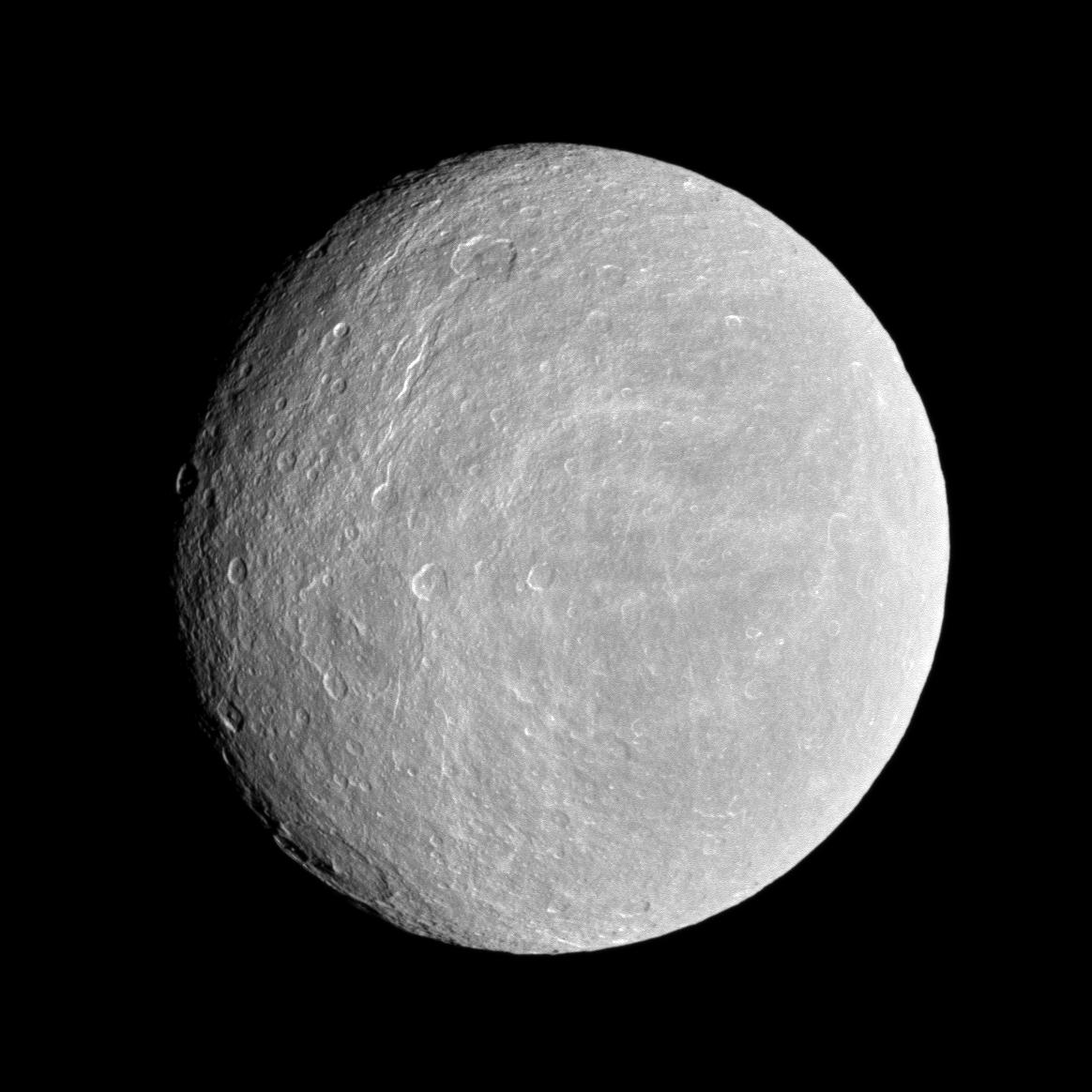Rhea

Giovanni Cassini discovered Rhea on Dec. 23, 1672.
Rhea is the second largest moon of Saturn, but with a mean radius of 475 miles (764 kilometers) it is less than a third the radius of Saturn's largest moon, Titan. Rhea is a small, cold, airless body that is very similar to sister moons Dione and Tethys. As with the other two moons, Rhea is tidally locked in phase with its parent — one side always faces toward Saturn — as it completes its 4.5-Earth-day orbit around the planet. Rhea's surface temperatures are also similar to Dione and Tethys, being roughly as warm as -281 degrees Fahrenheit (-174 degrees Celsius) in sunlit areas and ranging down to -364 degrees Fahrenheit (-220 degrees Celsius) in shaded areas. Also like Dione and Tethys, Rhea has a high reflectivity (or geometric albedo) suggesting a surface composition largely of water ice, which behaves like rock in Rhea's temperature range.
Rhea's density of 1.233 times that of liquid water suggests that Rhea is three quarters ice and one quarter rock. Cassini spacecraft measurements from a close encounter showed a moment of inertia about its axis (a measure of how difficult it is to change its rotation) of a higher value than what would be expected if Rhea has a rocky core. Thus, it is thought that Rhea is composed of a homogenous mixture of ice and rock — a frozen dirty snowball.
Rhea, at a distance of 327,500 miles (527,000 kilometers), is farther away from Saturn than Dione and Tethys, and because of this Rhea does not receive ample tidal variation from Saturn to cause internal heating. This has an important effect. Both Dione and Tethys have more areas of smooth plains than Rhea. Such plains are probably areas where liquid water reached the surface and ponded in depressions such as craters, forming flat surfaces before refreezing and thus erasing existing craters. The lesser internal warmth at Rhea could have resulted in fewer erasures or there could have been more bombardment on Rhea. Whatever the reason, Rhea is more heavily cratered than Dione and Tethys.
Rhea appeared as a tiny dot to astronomers until the Voyager (1 and 2) encounters in 1980 and 1981. The Voyager images showed that Rhea's features could be divided into two regions: the first being heavily cratered (bright) terrain with craters larger than 25 miles (40 kilometers) across and a second type of area in parts of the polar and equatorial region with craters less than 25 miles (40 kilometers) across. This difference may indicate there was a major resurfacing event some time in Rhea's history. However, it would have been long ago because there are few young craters with rays extending away from them (as on Earth's Moon). The average age of the plains is thought to be around 4 billion years old.
The Voyager images also showed mysterious linear "wispy" lines with lengths of tens to hundreds of miles, often cutting through plains and craters. In 2006, Cassini spacecraft images showed that the wispy areas are subsidence fractures that make canyons (some of them several hundred meters high). The walls of those canyons are bright because darker material falls off them, exposing fresh bright water ice. These fracture cliffs show Rhea may have been tectonically active in its past. This type of surface feature also occurs on Dione and Tethys.
The Cassini spacecraft detected a very thin atmosphere known as an exosphere, infused with oxygen and carbon dioxide around Rhea in 2010. It was the first time a spacecraft directly captured molecules of an oxygen atmosphere — albeit a very thin one — at a world other than Earth.
The oxygen appears to arise when Saturn's magnetic field rotates over Rhea. Energetic particles trapped in the planet's magnetic field pepper the moon's water-ice surface. They cause chemical reactions that decompose the surface and release oxygen. The source of the carbon dioxide is less certain.
Oxygen at Rhea's surface is estimated to be about 5 trillion times less dense than what we have at Earth. But the new results show that surface decomposition could contribute abundant molecules of oxygen, leading to surface densities roughly 100 times greater than the exospheres of either Earth's moon or Mercury. The formation of oxygen and carbon dioxide could possibly drive complex chemistry on the surfaces of many icy bodies in the universe.
In 2008, the Cassini spacecraft found evidence of material orbiting Rhea — the first time rings had been found around a moon. A broad debris disk and at least one ring appear to have been detected by a suite of six instruments on Cassini specifically designed to study the atmospheres and particles around Saturn and its moons.
The name Rhea comes from the Greek goddess (or Titan) Rhea, who was the daughter of Uranus and Gaea. Her husband was Kronus (the Roman Saturn). Rhea was also called the mother of the gods because she gave birth to several of the gods of Mount Olympus, including Zeus (the Roman Jupiter).
Cassini referred to Rhea as one of the four Sidera Lodoicea (Stars of Louis) after King Louis XIV (the other three were Tethys, Dione, and Iapetus). Astronomers also refer to Rhea as Saturn V denoting the fifth moon in distance from Saturn. Geological features on Rhea generally get their names from people and places from creation myths. The International Astronomical Union now controls the naming of astronomical bodies.




